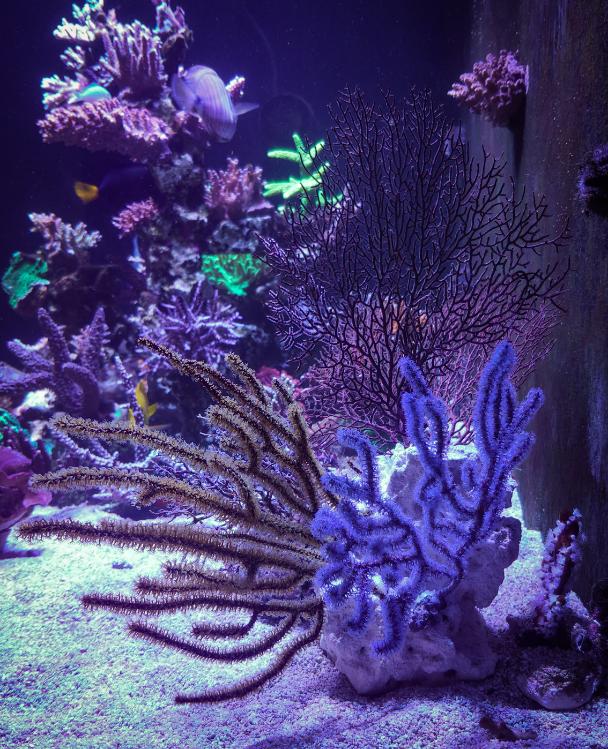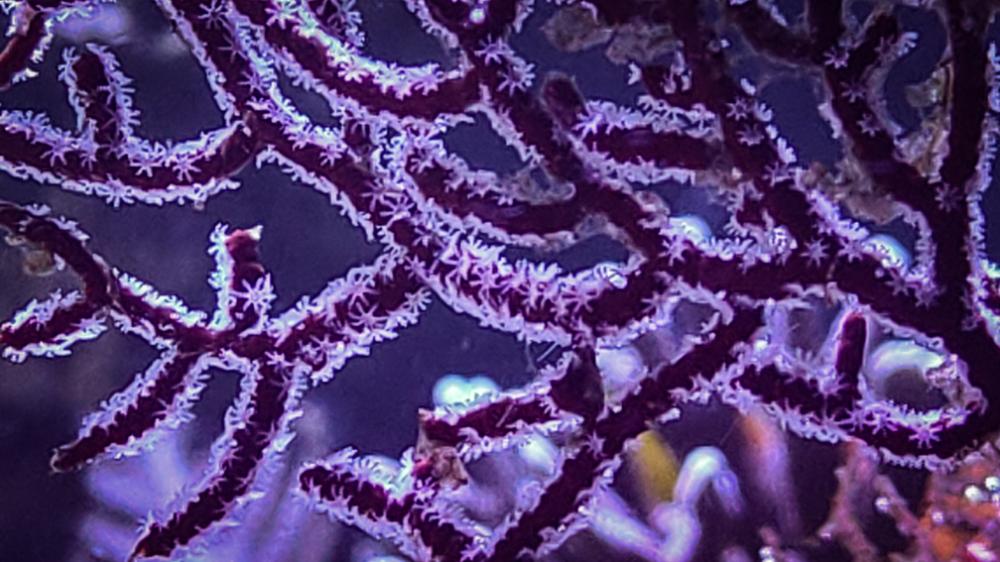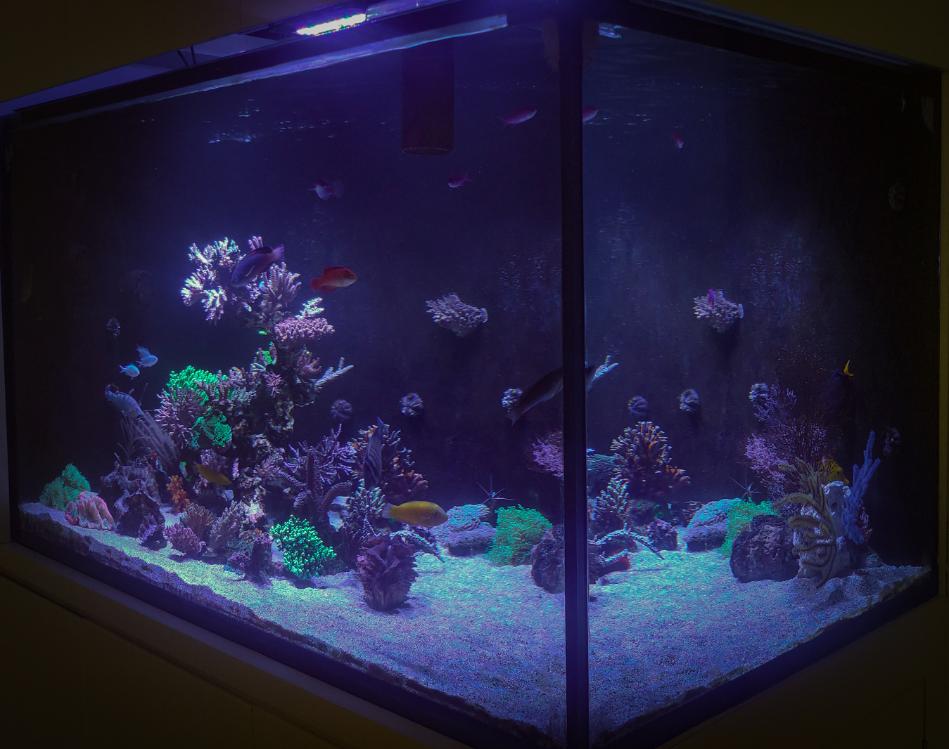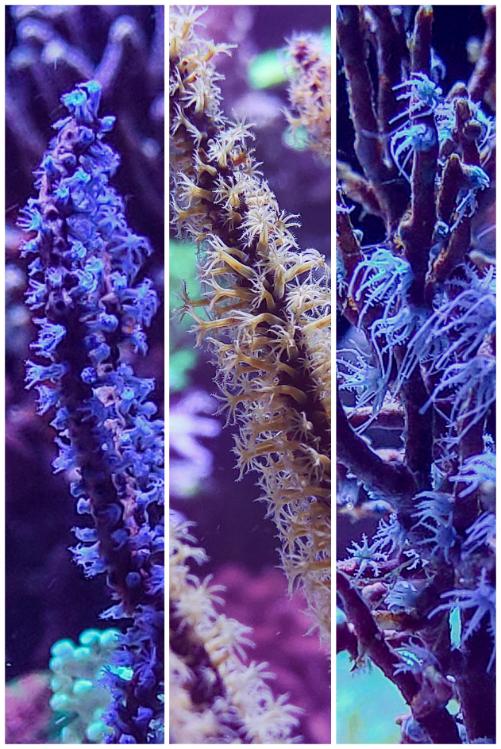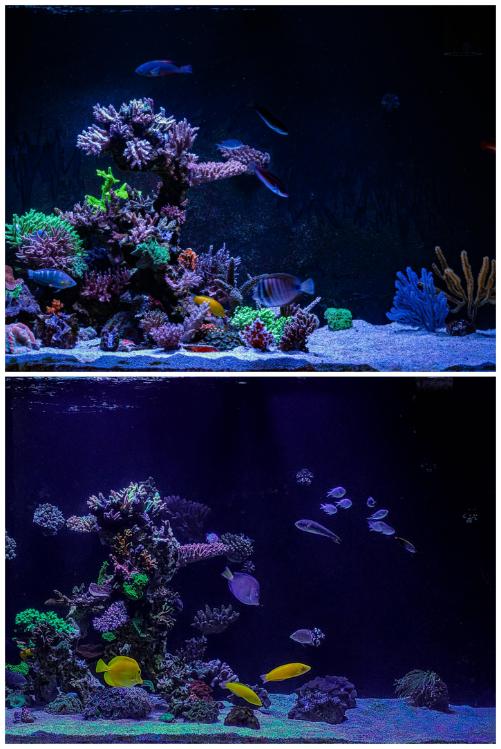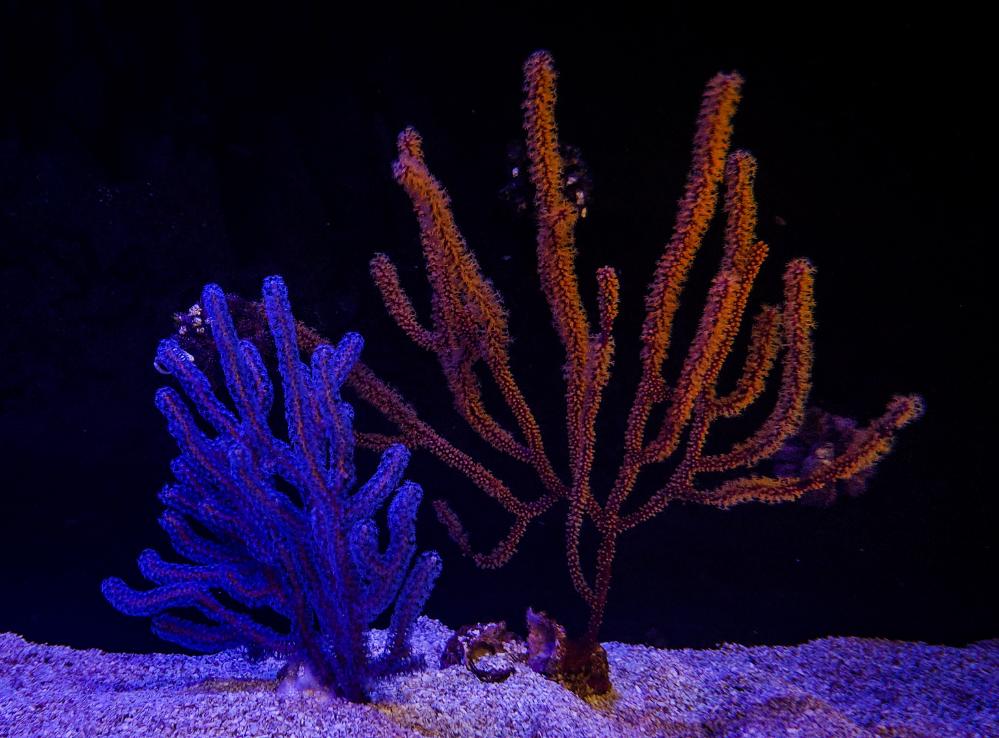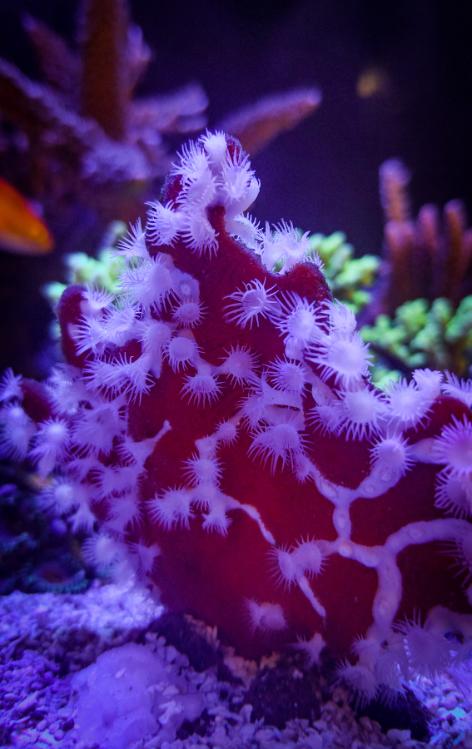-
Posts
304 -
Joined
-
Last visited
-
Days Won
15
Content Type
Profiles
Forums
Gallery
Everything posted by JiaEn
-
How about nutrient export? And did u measure phosphate?
-

[Urgent, need help] Disappearing Fish
JiaEn replied to Chromodoris's topic in New to the Marine Aquaria Hobby
Nassaurius snail can clean up a fish carcass in no time. It is possible that they died and cleaned up by the snails On the other hand, wrasses are good at hiding. One of my wrasse disappeared for 2 weeks before coming out of the sand again. -
How are you exporting nutrients? Also, what do you keep and how are you feeding them?
-
Carbonate and Reef Animals After looking at the abiotic (not related to biology) function of bicarbonate buffer, let's look at how reef organisms, such as corals and algae, make use of this important ion. Redfield Ratio although Redfield Ratio is often mis-apllied in the reefing context (take a look here), the various life form on the reef inevitably needs some elements, Carbon, Nitrogen, Phosphorus, Iron, etc. When we talk about carbon, aquarists will often think of organic carbon dosing. However the carbon atom in the bicarbonate ion is an important contributor of the carbon element into the biomass. The process of fixing this carbon into biomass takes place through a familiar process: photosynthesis. Photosynthesis In terrestrial plants. The process of photosynthesis consumes carbon dioxide, and produces glucose and oxygen. Same process happens in aquatic environments. In addition, may photosyntheic organisms can take up bicarbonate ions instead of dissolved carbon dioxide, and consume them during the photosynthesis process. Reef Building Of course, one most observable function of bicarbonate ions is the formation of coral skeleton. The coral tissies concentrates ions such as Bicarbonate, Calcium, Magnesium and Strontium, and cause them to precipitate and forms their skeletons. Thus the coral grows bigger. Nitrification The process of nitrification consumes bicarbonate ion. Fortunately, during denitrification, the consumed bicarbonate ion is "refunded". Therefore if the nitrogen cycle is allowed to proceed to completion, then there is no net consumption of bicarbonate. On the other hand, if nitrate accumulates in the aquaria, or is removed through other methods such as water change or algae refugium, then there is an overall decrease in bicarbonate during the whole process. I'm sure you will agree with me: bicarbonate is responsible for many crucial biological activities in the reef aquarium, far beyond building the coral skeletons. Therefore, ensuring that there is a stable and appropriate supply of bicarbonate in the reef aquarium is of paramount importance. We will explore this further in the next post.
-
Sibeh chim Oops Next one will be better... I think...
-
Carbonate Hardness Let's carry on from the previous post - alkalinity is not carbonate hardness, just that in most reef aquarium, most of the alkalinity is contributed by bicarbonate buffer. Bicarbonate buffer system is extremely important, not just for the corals, but for everything living on the Earth. So, what is a bicarbonate buffer? Without going into too much details, bicarbonate buffer consist of three chemicals: dissolves carbon dioxide, bicarbonate ions and carbonate ions. These three chemicals exists in seawater at different concentrations, and their ratio will determine the pH of the sea water. When the carbon dioxide level in the sea water increases - perhaps due to respiration of animals; or perhaps due to excess carbon dioxide in the atmosphere due to human activities. The carbon dioxide reacts with water, and eventually releases hydrogen ion, which can cause the pH to drop. Thanks to the buffer system, carbonate ion will take up this hydrogen ion (and turn into a bicarbonate ion), prevent the pH from dropping rapidly. This buffer system also allows the ocean to soak up large amount of carbon dioxide from the atmosphere. Without it, the effect of global warming will be even more pronounced. All these happens without the need of any intervention of living things. The bicarbonate buffer system defend the lives on the Earth, every single moment. However, it is not invincible. Remember seawater has a buffer capacity? The bicarbonate buffer cannot absorb carbon dioxide from air indefinitely. As the amount of dissolved CO2 increases, the pH of the ocean drops, abeit slowly. This is called ocean acidification. As we will discuss later, even a relatively small change in pH can affect living things dramatically. Thus CO2 emission really impacts coral reefs in many different ways. * the mechanism of bicarbonate buffer is simplified in this post. ** the bicarbonate buffer is also responsible for maintaining our blood pH, as well as regulate our breathing.
-
Alkalinity : More Than Meets the Eye Ask any reefer worth his salt, he will tell you keeping a stable alkalinity in the reef aquarium is of paramount importance. Most reefers soon learn to test, and suppliement alkalinity reasonably well. However, how does alkalinity influence the activities in the reef? Many reefers will say it helps to build the coral skeleton. This is true, but there are much more important processes requiring alkalinity in the aquarium. What is Alkalinity Alkalinity is a system of buffers. A buffer helps a mixture to maintain its pH within a reasonable range. It's like a shield, so to speak. When an acid is added into the seawater, alkalinity (the shield) will wear down first, before pH starts to drop rapidly. Conversely, when an alkaline is added, alkalinity will increase first, until the capacity is exceeded. Then the pH will skyrocket rapidly. So first thing to remember, alkalinity protects against both downward and upward shift in pH. This is one of the most crucial function of alkalinity in reef. We can test the alkalinity by the process of titration. We add acid to the water sample until the alkalinity is depleted, and the pH dropped sharply. That's the buffering capacity of the water. Source of Alkalinity in the Reef The alkalinity in the reef comes from two different buffer systems: bicarbonate /carbonate buffer and borate buffer. We shall look at these briefly so that we can have a good picture of what's in our sea water. Firstly, let's talk about borate buffer. Element Boron exists in seawater, but in small quantities (5ppm or so). Therefore the capacity of the borate buffer in a reef aquarium can be as high as 20% of the total buffer capacity. Boron is used by reef animals, but the consumption is rather low. Therefore it's not critical to test boron (no harm though). What we should keep in mind is, the titration reports total alkalinity. This means that the titration tests (salifert, alkatronic, etc) does not report the carbonate hardness (dispite many product says so). Then, the bicarbonate buffer. Bicarbonate ions are much more abundant (about 150 ppm) in seawater. As such, they are doing most of thr heavy-lifting for the buffer in the sea. The interaction of bicarbonate with the rest of the reef is complex and interesting. I'll spend the next post to discuss it.
-
Oh. They are called suprem5 corals and specialist aquatic solutions
-
One important consideration is that environment in the aquarium is probably different from the wild. Therefore the growth form if the coral in the aquarium may not resemble the "classic" shape in the wild. Therefore, if I'm looking for a typical tabling ledge of say, hyacinthus, I will get a nicely shaped colony to at least have the "correct" look. If not, having corals grow into their own shape will give rise to less flow and light problems.
-
Sea Fan Plus Sometimes, what we want and what the nature designed to be, are at odds. When I start to keep the sea fans, I intended for them to be a few unobstructive growth on the corner of the sand bed, kind of like a fringe growth. Alas it's not to be. Sea fans are non-photosynthetic. Therefore they require good low to filter feed from the water column. As such. They have the structure to catch the flow, just like a paddle or sail. This is fantastic, except that the tiny rock they are glued on cannot stay in place. The sea fan always topples, bends and generally require daily adjustment. Solution? One huge rock to glue all the sea fan together, while making sure they don't touch each other. Now they can wave all they want, and there is no risk of toppling any more. This is the big red sea fan with tiny white polyps. New resident. A two side view of the Acropolis.
-

Looking for guidelines and suggestions for aqua/rockscape..
JiaEn replied to SSunthar's topic in General Reefkeeping_
Hey. A few suggestions. 1. Ensure the rock work is stable and well joined together. 2. If the liverock is of good quality and relatively pest free, it can help your tank to mature faster. How confident are you regarding LR from hobbyist whom you don't know? 3. IMO, less rock, more coral. Provide caves and swim thru for your fishes, shelters for corals prefer less flow, as we as a mixture of varied light and flow conditions to suit different animals. 4. Composition wise, rule of third, negative space, depth, all these are ways to help the whole aquarium look balanced. 5. Before building the rockwork, it helps to picture the grown out aquarium in mind, how will different coral fill up the scape. Plan accordingly. All the best!- 2 replies
-
- 3
-

-
- mixed reef
- dryrock
-
(and 2 more)
Tagged with:
-
I wouldnt use the word imbalance. It's just a matter of what you adds in and what the coral is using. What are your existing values anyways? And what is the level you are aiming for? When we use a dosing product, actually our main purpose is to maintain the level. When it comes to balanced dosing product like all for reef, you can't really adjust one up, while leave the rest unchanged.
-
If your coral does not grow much, and you dose too much of any supplements, you will run into Kh Ca and Mg problems. All for reef is an easy to use product. Once you dial in your dosing, you can keep Kh within a very narrow range. The product is not the issue, the amount added is.
-
This is possible, especially with a regular refractometer designed for brine solution and sugar solutions. However for a properly made and calibrated refractometer for seawater application, it is spot on if you use it properly. Yes, but also, these will only be present in our reef water at very low concentrations. So it's not that much of a problem. This is actually fairly tricky, because microbubbles or another other inclusion in the liquid between probe junctions are going to mess up the conductivity reading. Also, the probe need to have temperature compensation and be properly calibrated to achieve a good reading. So pros and cons I guess. Anyway I'm splitting hairs here. Either instrument is good, and we just need to keep the reading from drifting. So even if the absolute value is not correct, we can still monitor the consistency.
-
Pen style conductivity probes can be inaccurate and inconsistent. I would say get a good optical refractometer is a good choice.
-
How do you measure the salinity
-
Let me chime in. There are some similar effects on sterilization, but ozone also have the ability to alter the water chemistry by oxidizing various compounds in the aquarium. For example it can breakdown some organics which can cause the water to appear yellow. Also the safety precaution between ozone and UV are rather different. Like what rob has described. It's important to have scrub off excess ozone before they escape into your room.
-
I'm slightly obsessed with sea fans recently. Their polyps can be really pretty and colorful. On a separate note, the sps did grow quite a bit. Although I don't keep kh at elevated level, the growth is still satisfactory. Looking at the aquarium everyday, I don't feel much of it. However, comparison to past photos is very telling. May 2021 vs Sept 2020
-
I agree with @ROB that sump driven circulation for the DT can be challenging to implement. The system flow will be capped by your overflow capacity, as well as the clarisea capacity. But I do see that you are going to use wm to supplement the dt flow. So that would definitely help. I love your idea of reversed undergraval filtration. I think in a long run, it would probably massively reduce your maintenance work. How about running the return pipes from the top, and implement a bleed hole at water line? IMO this is much more reliable compared to one way valve.
-
Test the Un-testable One core challenge of reefing is to simultaneously provide (inorganic) nutrient poor water, while provide ample nutrition for reef animals. Nutrition poor water, that's easier to test and manage. With competent range of test kits available, we can have a good grasp of the (inorganic) nutrient level in the aquarium. Should the level deviate from our preference, there are many ways to correct the problem. Nutrition, however, is a much greater mystery. Other than when we add food into the aquarium, we know precious little about amount of available food in the system. How long does the added food last in the aquarium? Does the animals only get to feed for 30 minute a day? If we can answer these questions, then we can confidently keep nitrate and phosphate at near zero levels, while ensure different type of corals can thrive. Turns out, we can test it. The Organic Test The test kit in question is not made by any commercial vendors, but nature itself. Sea fans. Sea fans are non-photosynthetic, and rely on capturing planktonic preys from the water column. In the presence of suitable food, the polyps extends rapidly. When the food becomes scarce, the polyps retracts. The contrast is obvious, and the response is rapid. In my aquarium, zeostones are agitated every hour to dislodge mulms for export and feeding. When that happens, within a minute or two, these sea fans will have their polyps fully extended. They remain this way for about 45 minutes, before the polyps started to retract. Until the zeostone gets churned again, and the cycle repeats itself. So I would infer that in my aquarium, corals have useful amount of nutrients 45/60 of the time. This also tell me that corals can get significant amount of energy need from feeding. Then I will have the confidence to drive nutrient even lower. Spider sponge showed some growth. Hopefully it confirms the good level of food in my reef. Use filter feeders as test for nutrition. What do you think?
-
Ah ok. If you put your siphon and secondary pipe (these two need elbow) on two ends, emergency drain in the centre. Probably enough space.
-
Absolutely! A very lovely piece
-
Do take note, bean animal style overflow can take up quite a lot of space.
-
It's a really nice piece! I think it's a noae. Maybe other experts can chime in.
-
Yes. It's a must have for noae. A lighter colored band around the tear drops. Depending on light conditions may be less obvious though. I guess @alvinyky best way is to take a look at the she'll from the side. See if it's symmetrical or not. If there is obvious elongation, then it's quite certain.


